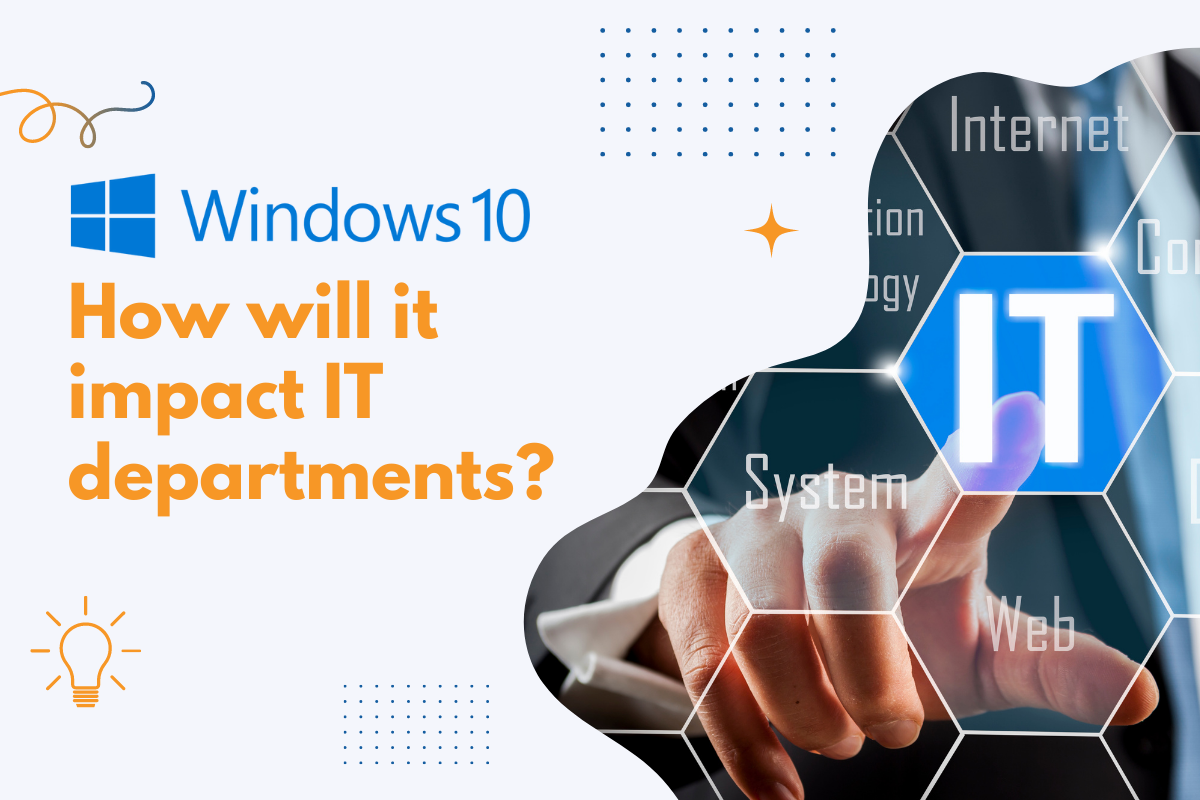Try PCmover
Please note the Evaluation copy of PCmover Enterprise requires you to be logged into a domain when testing. If you would like to test Enterprise without this requirement, please contact corpsales@laplink.com to receive an alternate copy of the software.
Thank you for your interest, and for choosing Laplink Software!
Contact Sales

Windows 10 Impact on IT departments and how to eliminate costly migration issues for Enterprises
The Windows 10 feature set suggests many areas which may impact IT departments in the future. A recent survey found that 80% of large enterprises and 71% of businesses plan to migrate to the new OS in the next 18 months after release, suggesting that it will be even more popular than Windows 7, which still commands a very large market share, particularly in enterprises. This was probably too optimistic, but the vast majority of organization are preparing their migration.
Microsoft has made it also very clear that a major focus of Windows 10 is the business users:
• Better usability via new, advanced Start Menu, better windows and desktop management (e.g. task viewer), seamless integration (windowing) of new “metro” apps, and so on.
• Better/faster/more secure browsing experience (Edge)
• Cross device familiarity and universal apps – this is very important for larger organizations. The ability to run and manage different form-factors with the same OS will accelerate mobile adoption in enterprise
• Enterprise apps can be built “once” and deployed (optimized) for all devices (although it is not that easy) – all supported via a central, unified App Store.
• Extended Mobile management
• Voice Recognition – Smart Assistance: Cortana can be a change agent of how consumer interact with the desktop PC. Voice recognitions and machine learning will enable new and innovative scenarios
• Lowering Cost of ownership
• Security improvements / Support of two factor authentication
Windows 10 promises to deliver advanced security and management capabilities along with ongoing innovation and security updates for businesses of all sizes. These new capabilities will deliver a host of benefits to organizations, enabling them to make key enhancements across their IT landscape and maximize ROI.
The Impact on Migration
Windows 10 will be the next big migration for IT teams to undertake, and they need to adapt to this reality if they are to continue delivering a positive and consistent user experience across the corporation. There are a number of key issues to consider, such as:
• The still existing base of machines running Windows XP (NT/Vista), adding to the complexity of deployed Windows 7 and 8/8.1 PCs.
• More migrations will occur simultaneously, including software, applications and devices. This means less time for IT teams to prepare and test new upgrades, likely resulting in issues following the deployment.
• Technical scenarios are these days are far more complex, with greater connectivity and interdependencies across systems and key applications.
• Scenarios are now more complex largely because of a multitude of devices and new form factors. Many new devices are running operating systems like Android and Apple iOS, thus adding to the complexity.
With so many migrations now taking place in increasingly complex environments, desktop or end-user oriented IT teams run the risk of underestimating the time, complexity and overall project management involved. Further, the impact of post migration help-desk support must also be understood and accounted for.
The end result is that it is more difficult than ever to deliver effective management of policies and user privileges, while providing a positive user experience.
Understanding the Cost Issues
We have broken down the most common complaints and the mistakes organizations are making that result in unexpected costs.
1. Many organizations underestimate the time end users spend to become familiarized with their new PC system, as well as problems with migrating existing user data, and settings recovery. This time can easily exceed three to four hours. These soft costs are often not part of IT budgets, but are of great concern for business owners experiencing employee-productivity drops.
2. End user customizations are frequently not considered in the overall plan. Customization are mostly left for the employee to complete on company time. Customizations like reapplying and creating settings for the new desktop can be beyond a normal users’ comprehension, leading to a surge in PC helpdesk requests with associated cost of $50 or more per call.
3. The third mistake is underestimating the logistics associated with PC migrations for users in remote locations and international subsidiaries, which can prove to be extremely difficult. The need to outsource to a contractor or flying a staff member to a site, causes deployment issues and costs to rise quickly.
4. The fourth, and final, mistake occurs inadvertently when data and settings are left behind. In a recent study conducted with enterprise level IT departments, the results were troubling: 27% of respondents who used various tools for transferring data and settings reported data loss in the process.
The Market for PC Migration Solutions
Windows 10 will cause businesses and IT teams to increasingly respect the fact that end user computing is changing. What is happening in the OS market is comparable to the BYOD revolution that saw the number and variety of devices on the corporate network sky rocket. This has and still is raises a number of challenges in terms of control and management.
The PC, tablets, and other devices have evolved into very powerful systems. Because today, we have dozens of vital applications, several gigabytes of data, and thousands of settings in the Windows registry, reestablishing all that on a new PC is time-consuming and near impossible to streamlined for a company.
With new PC deployments on the forefront of many IT teams’ tasks, issues surrounding the fact that there are few tools at the enterprise level to successfully complete this endeavor. Proven solutions like PCmover® Enterprise are not always known within many IT Organizations.
Organizations need a solution with minimal interruption to employees’ productivity, save time and resources, and will seamlessly migrate files, folders, and applications vital to each employee’s daily workflow. An IT professional at one of the largest PC manufacturers once stated: “We are supporting thousands of large organizations to deploy their PCs. We do everything from logistics, imaging, tagging, and bringing the PC to the workplace. We do not, however, have a solution for the actual migration between two desktops.”
Laplink developed a simple view into the Enterprise Value Quadrant. The costs associated with the migration are rules by two factors: the way PCs are managed, and the physical location of the PCs. If PCs are managed solely by the IT department, users do not have admin rights, data and settings are stored on servers, and the PCs are centralized within one location, then the benefit from PCmover tends to be minimal. However, if the PCs are managed by the users and are decentralized, the benefit from PCmover is the highest.
Experience indicates, there is no large organization that will fit into any of these quadrants solely, but rather will have different departments or groups that are scattered over this matrix. It can be assumed that PCmover might not be the tool for every PC, but it is the tool for every organization. It is the perfect tool for a managed migration of un-managed desktops.
An Effective Enterprise Solution
Laplink developed PCmover® Enterprise to make the workstation migration process effective and cost-efficient. It automates the transfer of selected applications, data, and settings to a new PC. This including user accounts, applications’ environments, applications’ add-ons, background pictures, favorites, and more.
PCmover Enterprise is an OS-independent transfer tool that allows to migrate to the newest version of Windows, including Windows 10. All migration scenarios are supported, and it has been proven successful in migration projects ranging from 100 to 100,000 PCs.
PCmover Enterprise has an easy-to-use wizard that does not require any developer knowledge and enables the IT Administrator to set the rules. IT departments are able to predefine certain rules and policies within the organization to fit all cases.
The Policy Manager allows IT Administrators to pre-check a variety of choices within the program to create a predefined version of the product that can be executed by a user or an IT engineer with minimal interaction. The experienced user might require all options to be open to them, but most users in an organization may be better off with a no-touch or light-touch solution to minimize user errors.
PCmover Enterprise by Laplink Software is the solution for every organization that has over 100 PCs. It will save a minimum of $300 per PC deployed, eliminating the need for extended project cycles. Using PCmover helps organizations decrease unbudgeted costs during the projects, and dramatically decreases productivity loss.
No matter where you are in your deployments of new PCs or operating systems, PCmover® Enterprise will help make the process streamlined, cost-effective, and efficient.
Thomas Koll, CEO

As Chairman of the Board and CEO of Laplink, Thomas guides the company’s strategic direction. Prior to joining Laplink in 2003, Thomas was Chairman of the Board for Infowave, where he was involved in interfacing with global business and financial communities. Thomas also served as Infowave’s Chief Executive Officer from February 2001 to April 2002. Prior to joining Infowave, Thomas worked at Microsoft for more than 13 years. He was Corporate Vice President of Microsoft’s Network Solutions Group where he was responsible for Microsoft’s worldwide business with telecommunication companies. Thomas was instrumental in developing Microsoft’s vision for the communications industry and led the development of strategic partnerships in mobility, broadband and hosting. Previously, he was General...
Read more about Thomas Koll, CEO...

Add Comment